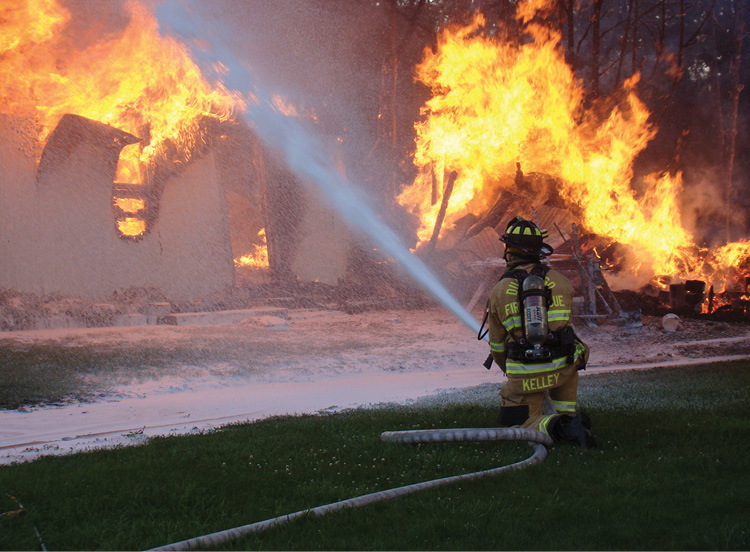
When an engine company responds to an incident in the wildland urban interface (WUI), it must protect life and property—just as in structural firefighting—but it must also be prepared to mitigate many WUI-related challenges such as access to a sufficient water supply and extremely limited ingress and egress points. It is imperative that the engine company train for the many issues that may severely hamper or delay its operations. This is particularly true for structural firefighters whose job traditionally has not involved responding to WUI events.
RELATED
The Roaring Lion: Strategies for Community Preplanning for WUI Incidents
WUI Fires: Some Tactics and Lessons Learned
The Importance of Wildfire Evacuation Drills to At-Risk Communities
As fires in the WUI continue to increase, many structural departments are being called to respond to large WUI conflagrations, which means they must be ready to perform structure protection as well as determine escape routes; maintain communication; establish safety zones; and factor in weather, fuel types, and topography. In short, fighting a WUI fire is much different from fighting a structure fire. Therefore, structural engine crews must be ready to perform engine operations for an entirely different environment than the ones they’re used to.
Preplanning
Before any engine crew sets foot in the WUI, and no matter what its task is once it’s there (initial attack or structure protection), you must preplan your WUI areas if you want to stay ahead of the game when an incident occurs. When preplanning, assess the area’s potential for losing homes, and identify any major issues and potential challenges. For example, determine if the area is hydranted or has static water sources. If there are no hydrants, determine how many static water sources are available and whether an engine crew can access them easily. Also determine things like bridge load limits, steep grades on any roads or driveways, how to maneuver apparatus into a WUI area if roads are narrow or unpaved, or when the occupants are trying to use the same road to evacuate.
Water supply can be a challenge for firefighters in the WUI. Familiarization with and preplanning of water supply locations within WUI areas are musts. Although water tender operations may be the norm in most rural areas, fire departments with hydrants in their WUI areas must also train in water tender operations. If a water system failure occurs, this may be the only water supply option. This training should include nursing off a tender, drafting to feed a supply line, setting up portable tanks, and performing water shuttle operations.
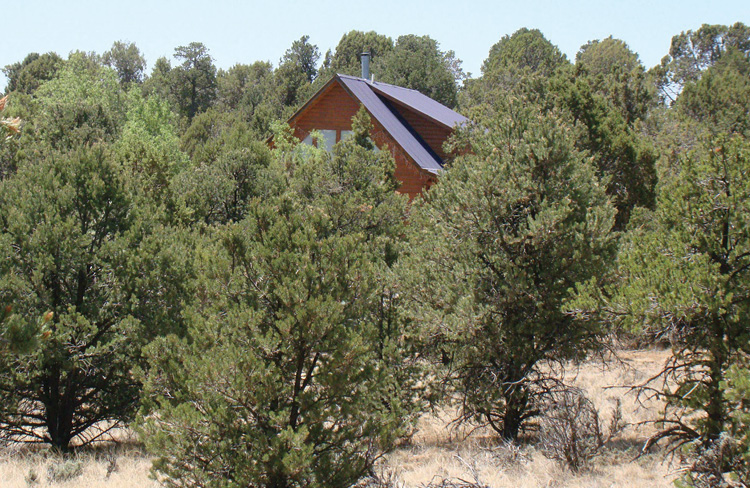
(1) Preplanning should include an assessment of defensible space for structures within the wildland urban interface (WUI). (Photos by author.)

(2) The age, condition, and load limits on this bridge may preclude some types of fire apparatus from crossing it.

(3) The dry hydrant installed at this pond provides a static water supply for fire suppression.
Wildland Fire-Specific Hose and Stretches
There are some considerable differences between wildland and structural fire hose and deployment tactics. Wildland hose is generally constructed of cotton, linen, or synthetic fiber and does not have a rubber interior lining. The two advantages to this are that it decreases the weight of the hose while increasing the hose’s self-protecting (weeping) characteristics. Without interior lining in the hose, the hose’s outer jacket remains wet and appears to be “weeping” water.
Wildland hose sizes range from 5⁄8 to 2½ inches. Much like a booster line, you can deploy the smaller sizes from reels. For a progressive hoselay, you can use backpacks, which allow firefighters to create long lays in a short time. Keep in mind that the couplings on wildland hose may or may not be compatible with the threads on some structural engines.
One of the most significant and time-tested ways to knock down a wildland fire is to use a progressive hoselay. Understanding how to perform this type of lay in a safe and timely manner at a WUI fire is crucial to structural engine crews because it not only protects property but it’s also a quick and effective way to ensure firefighter safety. The progressive hoselay is used specifically on the flanks of a wildland fire and may follow a handline made by hand crews; it can also be used to create a “wet line” along the fire’s edge. This lay generally includes a 1½-inch hose as the feeder line with one-inch hose branched from it, usually every 100 to 150 feet. You may use this tactic in the WUI if your initial actions include attacking the wildland fire and you have a sufficient water supply.
Initial Attack vs. Structure Protection
The objective of an initial attack is to stop the fire’s forward progress so that crews can extinguish the fire in a safe manner. In an initial-attack response, a well-trained and well-equipped engine crew may carry out a planned assignment for the incident at hand, given the fire’s potential behavior in a WUI area. Base this planned assignment on the analysis of hazards and preplanning within your WUI areas, strategies and tactics, various assignments, and resource ordering that may be spelled out in that plan or analysis. Given the size of many WUI fires these days, always consider the abilities of first-arriving resources. If the fire is too large to attack safely or contain, revise initial-attack strategies and request additional resources.
Structure protection in the WUI is NOT the same thing as the initial attack. Rather, it involves the basic protection of homes or other buildings from a wildland fire. Specifically, engine crews evaluate the location of the threatened structure and their ability to defend it given the surrounding area (i.e., fuels and topography), weather, and fire behavior. If they determine that the structure can be saved and they have the resources to defend it, they will do so.
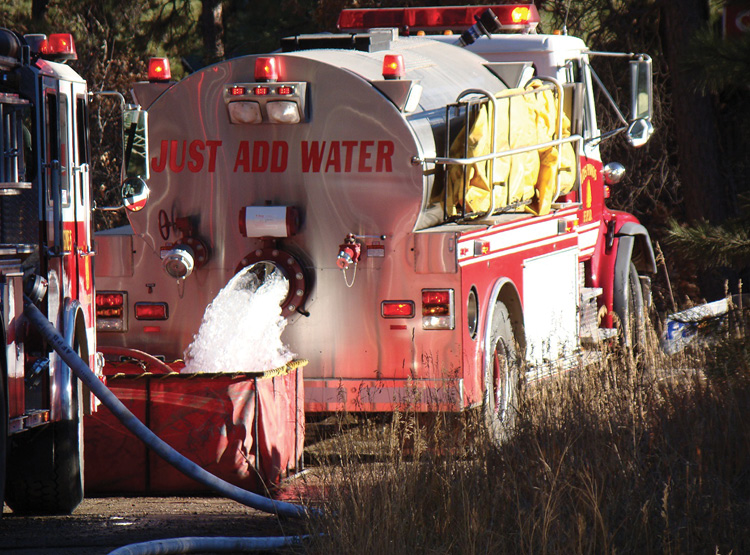
(4) Even if hydrants are installed in their WUI areas, fire departments must train on water tender operations.

(5) You can use a hose backpack to complete a long hoselay in a short time.
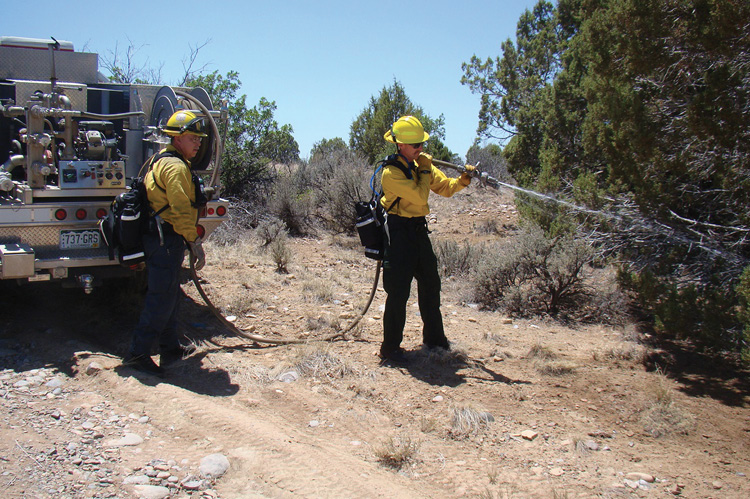
(6) Firefighters create a wet line using the hose reel mounted on the brush truck.
Prior to performing structure protection, conduct a risk/benefit analysis to ensure firefighter safety. For detailed information on how to complete a risk/benefit analysis for a WUI incident, refer to the WUI section of the National Wildfire Coordinating Group’s Incident Response Pocket Guide. Protecting ALL structures from a WUI fire won’t always be possible because of risks to personnel, fire behavior, and the availability of additional resources. Therefore, you may have to employ structural triage protocols.
When Fire Threatens a Subdivision
When a WUI fire approaches a neighborhood, residential area, or subdivision, engine crews should employ the following tactics and strategies:
Size up the situation to determine what actions to take and what resources are needed. Engine crews will need to implement the proper tactics quickly to defend structures from the flame front. If, during size-up, they determine that the fire is spreading more rapidly than initially reported or is threatening multiple homes, they will need to call for additional resources.
Identify escape routes, safety zones, and temporary refuge areas (TRAs). Using lookouts, communications, escape routes, and safety zones is critical to the safety and survival of any firefighter working at a WUI fire. There may be times when good safety zones or viable escape routes are identified. However, they may not be immediately accessible should extreme fire behavior occur. A TRA may be more easily developed in the WUI environment.
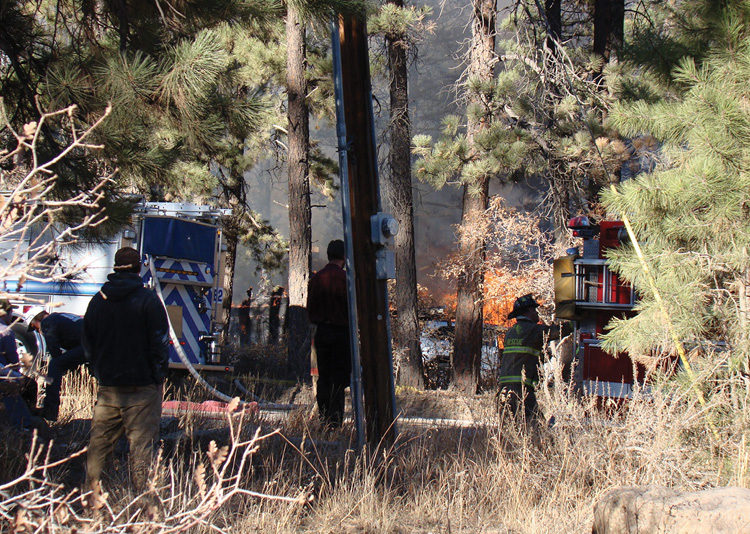
(7) Available resources and fire conditions on arrival impact initial attack strategies.

(8) Rapid fire spread and structure involvement dictate the need for additional resources.
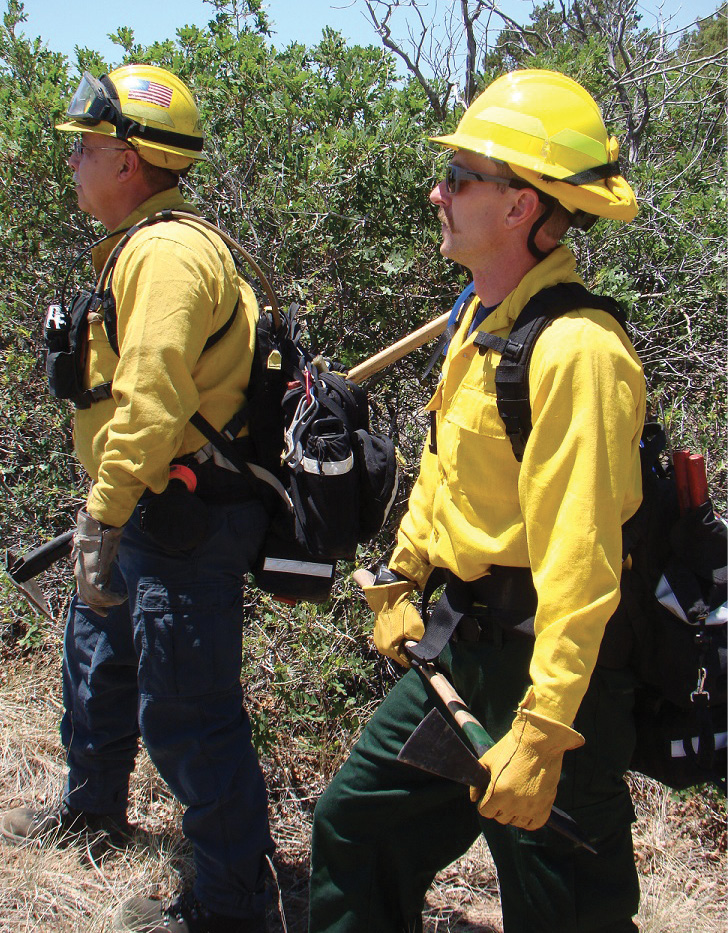
(9) You can fight fire in the WUI in wildland or structural firefighting gear, depending on your assignment. Firefighters MUST be in full personal protective equipment.
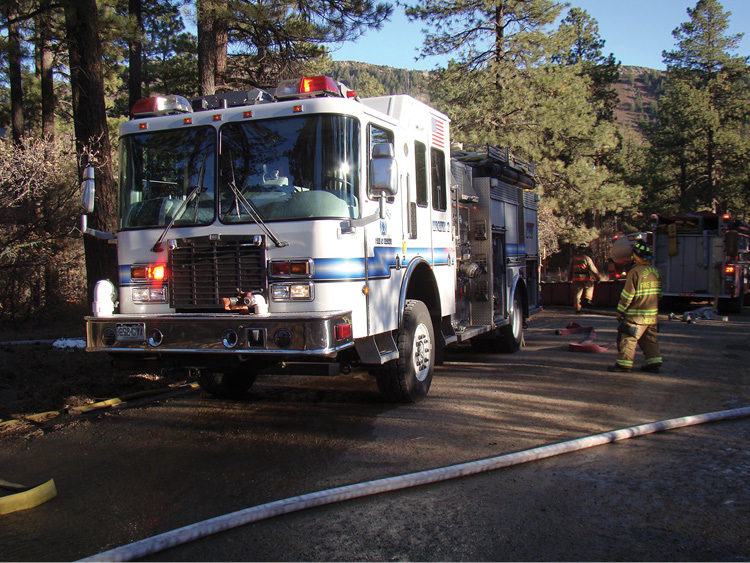
(10) The need for fire apparatus and personnel to evade deteriorating conditions creates the demand for keeping escape routes clear of equipment.
Wear all your personal protective equipment (PPE). Although you can perform some structure protection tactics while wearing standard wildland PPE, if a building becomes involved in fire and you decide to attack the fire, changing into structural PPE—including self-contained breathing apparatus—will be necessary.
Park in a cleared area and watch for hazards such as combustible vegetation, overhead power lines, propane tanks, and other obstacles that would prevent you from making a hasty retreat from the area.
Keep a charged hoseline available. Keeping a 50-foot section of hose charged and ready at the apparatus will provide additional protection to personnel and apparatus. Also, do not let your tank water level drop below one-quarter full.
Try to maintain visual and radio accountability with your crew. You can accomplish accountability at a WUI or structure fire in many ways. Find additional information on WUI fire accountability in Firescope California’s Field Operations Guide or Firefighter Incident Safety and Accountability Guidelines—ICS 910.
Top off your water tank at every opportunity. Be aware that hydrants may not always work if the water system is electrically powered and power in the area is lost, so fill up at any working hydrant, drafting station, or water tender when you’re able.
Staying Mobile
Apparatus mobility in the WUI is extremely important given the terrain you may encounter. In addition, wind can change direction at any moment, sending embers and fire in a completely different direction and possibly threatening your apparatus and crew. To ensure firefighter and apparatus safety, crews must continuously assess fire behavior, weather, fuel types, and so on, and keep the following items in mind.
Back in equipment for a quick escape. Your apparatus and crew must be prepared to “cut and run” should conditions deteriorate. This means you must be prepared to disconnect hoselines at the pump panel and leave them. Also, never park the rig under trees or next to other vegetation. In the event of a rapidly spreading fire, positioning apparatus anywhere near combustible vegetation creates a situation where the rig becomes an exposure problem.
Keep escape routes clear. Not only must you identify a realistic escape route, but you may also need to clear it for crews to reach a safety zone or a TRA. If a driveway or road is being used, remove any hazards that would impede your fleeing the area. Remember, designating one escape route is good; designating two is better.
Avoid long hoselays. Consider using hoselays no longer than 200 feet. For structure protection, deploy a 1½- or 1¾-inch line. Also consider using only fire hydrants to keep your tank filled. The intent here is to remain mobile. Using a hydrant for a fill spot can accomplish this, but using a nurse water tender or other static source can work as well. The thought is to come in, get your water, and move out. At a static water supply, you may want to use a portable pump to avoid drafting with the apparatus.
In structural and wildland firefighting, protecting life and property are the top priorities. However, a WUI fire is very different from a structure fire; it has no walls to contain it. Structural engine crews responding to WUI fires must develop a firm understanding of the growing WUI environment, WUI-specific tactics, wildland fire behavior, and the risk management process if they want to successfully extinguish a WUI fire. The WUI environment offers many challenges, but with proper training, understanding, and resources, structural engine crews can become just as proficient in WUI firefighting as they are in structural firefighting. And with the growing WUI environment, the option to do so is quickly becoming a necessity.
THOMAS W. AURNHAMMER is a 42-year fire service veteran, a fifth-generation firefighter, and chief of the Los Pinos Fire District in Ignacio, Colorado. He is a graduate of the National Fire Academy’s Executive Fire Officer Program and has a bachelor of science degree in fire administration. Aurnhammer also has the Chief Fire Officer designation and is a member of the Institution of Fire Engineers, U.S. Branch.

